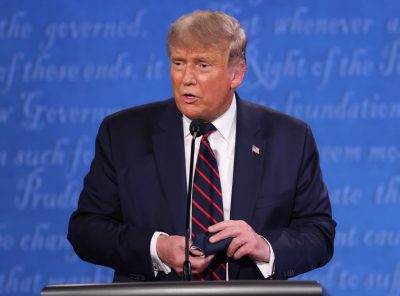
President Trump refused to categorically denounce white supremacists on Tuesday night, diverting a question about right-wing extremist violence in Charlottesville, Va., and Portland, Ore., into an attack on “left-wing” protesters.
“Are you willing tonight to condemn white supremacists and groups to say they need to stand down and not add to the violence and number of the cities as we saw in Kenosha and as we’ve seen in Portland?” Chris Wallace, the moderator, asked the president.
“Sure. I’m willing to do that,” said Mr. Trump, quickly adding, “Almost everything I see is from the left wing. Not from the right wing.”
When Mr. Wallace pressed on, the president asked, “What do you want to call them?”
“White supremacists,” the moderator replied.
“Proud Boys — stand back and stand by,” he said, apparently addressing the far-right group. “But I’ll tell you what. I’ll tell you what. Somebody has to do something about antifa and the left. This is not a right-wing problem. This is left wing.”
Mr. Trump highlighted left-wing violence when asked to condemn white supremacists, despite racist extremists’ committing more lethal attacks in recent years. Kenneth T. Cuccinelli, the acting deputy secretary at the Department of Homeland Security, said days later that “when white supremacists act as terrorists, more people per incident are killed.”
When Mr. Wallace pointed out that Mr. Trump’s own F.B.I. director, Christopher A. Wray, had said that antifa is an idea, not an organization, the president replied, “You have to be kidding.” (The director also said this month that “racially motivated violent extremism,” mostly from white supremacists, has made up a majority of domestic terrorism threats.)
WATCH: When asked if he would condemn white supremacy, President Trump said: "Proud Boys, stand back and standby." https://t.co/N9lBlASEGm pic.twitter.com/Q7yHAHqJR6
— CBS News (@CBSNews) September 30, 2020
The exchange came after a rambling discussion about law enforcement and protests.
Mr. Trump, under fire for his handling of the coronavirus crisis, has tried to turn the election — so far unsuccessfully — into a referendum on Joseph R. Biden Jr.’s reaction to the protests and sporadic street violence that came after the killing of George Floyd in police custody.
From the earliest days of his presidency, Mr. Trump has repeated falsehoods about the national murder rate and has seized upon outbreaks of violence in American cities to make the case that Democrats are unfit to lead.
Mr. Biden has tried to walk a narrow political line, expressing support for the aims of peaceful protesters and the Black Lives Matter movement while repeatedly expressing his disapproval of violence.
“Burning down communities is not protest,” he said last month during a visit to Kenosha, Wis., where Jacob Blake, a Black man, was shot multiple times by the police with his children nearby.
Mr. Trump’s strategy does not seem to be working beyond his base. Recent polls in battleground states have shown that most voters view the protests as justified. And a recent Quinnipiac University national survey of likely voters found that only 35 percent felt Mr. Trump could make the country safer.